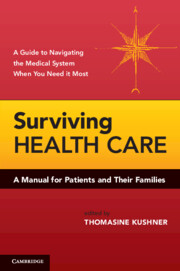Book contents
- Frontmatter
- Contents
- Contributors
- Preface
- 1 Letter to Patients
- 2 Becoming an Active Member of Your Health Care Team
- 3 Information That Will Help You with Advance Planning for Your Health Care
- 4 Responding to Medical Emergencies
- 5 What You Need to Know about Medical Errors
- 6 Being Informed When You Give Consent to Medical Care
- 7 Beware of Scorecards
- 8 Transplantation 101
- 9 When the Illness Is Psychiatric
- 10 On the Horizon
- 11 To Be or Not to Be – A Research Subject
- 12 Information That Will Help You Make Health Care Decisions for Adult Family Members
- 13 Caring for Individuals with Alzheimer's Disease
- 14 When the Patient Is a Child
- 15 Care of Elders
- 16 Being and Thinking
- 17 A Patient's Guide to Pain Management
- 18 The Hardest Decisions
- 19 What You Need to Know about Disasters
- 20 Making the Internet Work for You
- Appendix: Patient Individual Profile
- Index
17 - A Patient's Guide to Pain Management
Published online by Cambridge University Press: 05 June 2012
- Frontmatter
- Contents
- Contributors
- Preface
- 1 Letter to Patients
- 2 Becoming an Active Member of Your Health Care Team
- 3 Information That Will Help You with Advance Planning for Your Health Care
- 4 Responding to Medical Emergencies
- 5 What You Need to Know about Medical Errors
- 6 Being Informed When You Give Consent to Medical Care
- 7 Beware of Scorecards
- 8 Transplantation 101
- 9 When the Illness Is Psychiatric
- 10 On the Horizon
- 11 To Be or Not to Be – A Research Subject
- 12 Information That Will Help You Make Health Care Decisions for Adult Family Members
- 13 Caring for Individuals with Alzheimer's Disease
- 14 When the Patient Is a Child
- 15 Care of Elders
- 16 Being and Thinking
- 17 A Patient's Guide to Pain Management
- 18 The Hardest Decisions
- 19 What You Need to Know about Disasters
- 20 Making the Internet Work for You
- Appendix: Patient Individual Profile
- Index
Summary
Some (hopefully not all!) of what you are about to read in this chapter may strike you as quite strange and perplexing. The reason is that since the rise of more scientifically and technologically oriented medicine in the middle of the last century, physicians and laypersons have had very different (and sometimes even conflicting) views about the relationship between pain and suffering and the responsibilities of the medical profession to effectively relieve them. Surprisingly, before the rise of the modern era, physicians took their responsibility to relieve pain much more seriously than they do now. It is as though the less physicians could do to treat or cure disease, the more assiduously they strived to ensure their patients were at least comfortable and certainly not suffering from pain or other distressing symptoms of illness when the means of relief were available somewhere in the physician's toolkit.
With the rise of modern medicine and the many remarkable advances in medical science and technology, many previously incurable diseases became curable or at least manageable for increasingly longer periods of time. As the focus shifted to making a prompt and accurate diagnosis and then selecting and effectively implementing the most appropriate treatment, what appeared to fade into the background was the patient's experience of illness, including pain and other symptom distress.
Pain – and more importantly, the perceived duty to promptly and effectively treat it – receded so far into the background that by the late twentieth century, there arose what only quite recently (at least when considered in the broad scope of the history of medicine) has come to be recognized as an epidemic of undertreated pain.
- Type
- Chapter
- Information
- Surviving Health CareA Manual for Patients and Their Families, pp. 246 - 263Publisher: Cambridge University PressPrint publication year: 2010
- 2
- Cited by



